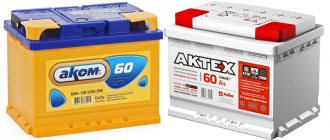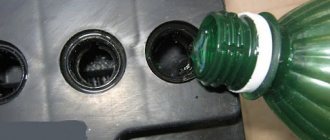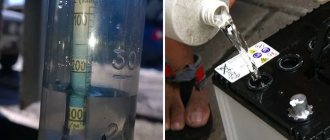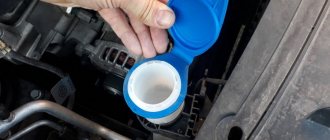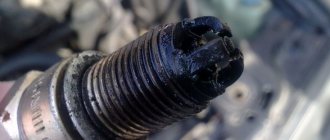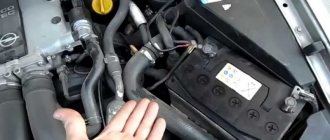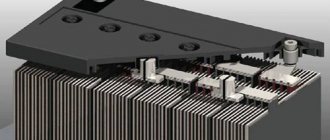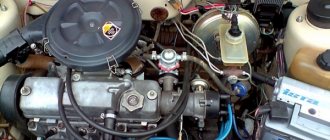Before the onset of winter, it is necessary to properly prepare the car so that all components and assemblies function properly in conditions of reduced temperature. Preparatory procedures include: changing oil, fuel filters, tires, checking the quality of antifreeze and antifreeze, charging the battery. The latter, as a power source, requires the right approach. It happens that the driver discovers that the electrolyte in the battery has frozen. What this means and how to eliminate the phenomenon and prevent it from happening again is in the article.
Freezing of the electrolyte in the battery is possible when the temperature drops.
Why does the electrolyte in the battery freeze?
Electrolyte is a conductive medium located in the so-called “banks” of the battery. This is a liquid mixture of sulfuric acid and distilled water. The “chemistry” density parameter is 1.27 – 1.28 g/cm3. At this value, the freezing temperature is about -70°.
If the company preparing the electrolyte adhered to the production technology and did not make mistakes, you can be sure that it will not freeze even in the severe frost typical of the northern regions. If the density parameter is different, even a new power source will be covered with ice.
The density drops in such cases: the battery is deeply discharged or distilled water has been frequently added to it. Typically, a deep discharge occurs due to overload by consumers, but a simple machine can also lead to this. So, a used, that is, not new, battery can die in 1 to 2 weeks when idle. A newly purchased battery loses approximately 0.1% of its charge per day. And winter only speeds up this process.
As for adding water, in this case the intensity of the decrease in the density of the electrolyte is different. If the conductive liquid has evaporated, adding water will return it to its original density. If the reason for the addition is damage to the housing or splashing of “chemicals,” the density will noticeably drop.
Gray or black electrolyte is bad!
Let's say you defrosted the battery, but when you looked at the cans (battery compartments), it or two took on a black or thick gray color. I want to say right away, go get a new battery, what does this tell us, but nothing good:
When the water froze, it damaged the lead plates and simply destroyed them, or, if you like, tore them. After the electrolyte has defrosted and turned back into liquid, these compartments no longer have structured plates, but simply a bunch of lead that was mixed in the jar, which is why it became cloudy. Even if one bank fails, the voltage will drop by 2 Volts, that is, the nominal value will be 12 and 10 Volts. Such a battery will not be able to start your car, and what can it start, it is not even able to “soak” the car’s systems (radio, ECU, dashboard, etc.). This is the “death” of the battery.
Of course, many manage to restore this jar by cutting the top and pulling out - restoring the package of lead plates. But for an ordinary car enthusiast, this is very difficult and almost impossible. Let's go get a new battery.
Electrolyte freezing table
Most cars have lead-acid batteries with liquid electrolyte, the water in which can freeze in the cold and turn into ice. How the freezing temperature depends on the density of the mixture is shown in the table.
| Density (g/cm3) | Freezing point (°C) |
| 1.14 | -14 |
| 1.15 | -16 |
| 1.16 | -18 |
| 1.17 | -20 |
| 1.18 | -22 |
| 1.19 | -25 |
| 1.20 | -28 |
| 1.21 | -34 |
| 1.22 | -40 |
| 1.23 | -42 |
| 1.24 | -50 |
| 1.25 | -54 |
| 1.26 | -58 |
| 1.27 | -68 |
| 1.28 | -74 |
| 1.29 | -68 |
| 1.30 | -66 |
| 1.31 | -64 |
| 1.32 | -57 |
If everything is in order with the battery, it was operated in compliance with the rules, it was recharged on time and correctly, the consequences in the form of frozen electrolyte will not occur. Experienced drivers adhere to this rule - if the density of the electrolyte has dropped, it’s time to charge the battery.
How to charge a frozen battery
If the battery has thawed and you have not found any cracks or deformations on it, you can charge it. To do this, it is recommended to use an automatic charger. First, the ASU applies a pulsed current, due to which sediment is removed from the plates. Then 5% of the charging current of the total capacity is supplied. That is, a 60A battery will be recharged with a current of 3A. This charging lasts for 8-10 hours with a gradual decrease in current strength. Do not overcharge a defrosted battery.
Experts also recommend checking the transparency of the electrolyte. If it is cloudy, there may be a short circuit. This indicates that the plates are crumbling, which means the battery is out of order.
Battery resuscitation
The battery is a rather capricious device. With proper care, the power supply will easily last 3-5 years without causing any complaints. But different things happen.
Having noticed that ice has formed on the case and the electrolyte has frozen, the first thing they do is remove the battery from the socket, disconnecting it from the contacts. Then they are taken to a warm room and placed in a suitable container, for example, a basin. Why this is done: if the housing is damaged due to freezing and a microcrack has formed, electrolyte will flow from it. It will not be possible to operate a battery without “chemistry”, that is, resuscitation will not bring results.
Battery reanimation process.
If nothing leaks, you should wait until the battery and electrolyte warm up to room temperature. You cannot immediately charge a frozen car battery - you need to evaluate the condition of the case again. If cracks and unevenness are still noticeable, just dispose of such a battery. Some will say that small cracks can be easily repaired with the same mastic, but the point is different. The power supply froze so hard that its casing began to collapse. If it came to this, then the metal plates had definitely deteriorated.
In those “banks” where the plates are warped, a short circuit is likely to occur. If the separator separating the polarities is damaged, a short circuit cannot be avoided. It can be eliminated, but it takes a lot of time and effort.
If no visual damage is detected, all that remains is to wait until it has completely thawed and charge it with a charger. The current strength is set to 10% of the actual energy intensity. A full charge will take about 10 hours. At the end, measure the voltage at the battery terminals. The minimum should show 12.6 V. If the number is, for example, 10.5 V, then one of the “cans” has gone bad (the parameter for one element is 2.1 V). Measuring the density of each can will help you find the “outdated” one. For this you need a hydrometer.
If, after the charge is restored, the density of each element is at the level of 1.27 g/cm3, and the voltage is within 12.6 - 12.9 V, then the “freezing” did not lead to negative consequences, and the battery will still work. The only thing is that in winter it is recommended to slightly increase the density, up to 1.3 g/cm3.
What to do if the electrolyte is frozen
If in the morning you cannot open the car door or the engine does not start, then the battery is dead. In frosty weather this occurs due to freezing of the electrolyte. Signs of a frozen battery: swollen case walls and a layer of frost. To prevent the battery from freezing:
- Do not leave it in a discharged state for more than 24 hours in the cold;
- Check it for current leakage in the circuit;
- Do not let your car sit for long periods of time in winter.
When the device freezes, the plates and separator may become deformed and cracks may appear, so such a battery cannot be immediately connected to charging. To deal with the problem, follow the plan:
- Remove the battery;
- Inspect it for cracks and other damage;
- Place the device in an enamel bowl and wait until the ice melts and the body returns to its normal shape.
- If you do not find any deformation, charge the battery according to a special schedule.
First, use litmus paper to check whether the moisture on the case is harmless. A small amount of electrolyte may leak through microcracks that are not visible to the eye. If the indicator strip does not turn red, then everything is in order.
Do not place a frozen battery in hot water. If you need to defrost the charger as quickly as possible, immerse it in cold water and gradually increase the temperature or use a heat gun.
Preventing electrolyte freezing in the battery
Recommendation – timely maintenance:
Battery case.
- in regions with harsh winters, the density can be increased to 1.3 g/cm3;
- The battery must always be charged. In winter it’s difficult for her; she doesn’t have time to recharge from the generator, so she’ll need a charger;
- cases for batteries are practiced, and such protection can be made yourself;
- some people prefer to take the battery home at night.
A frozen battery is an unpleasant occurrence for the driver. First, you need to let it thaw, then measure the electrolyte density level. If it’s normal, they charge it and continue using it. But it’s better not to let it get to that point, adhere to the operating rules, and carry out regular maintenance.
How should you look after your car battery?
To increase the service life of the battery, it is necessary to monitor its condition by checking the electrolyte density, its level and charging before changing seasons.
This is especially true before the onset of cold weather.
But, despite periodic scheduled battery maintenance, any battery can be discharged in the cold. It all depends on air humidity and air temperature. In order not to find yourself in a difficult situation associated with a discharged battery, each owner must purchase an electric charger, with the help of which any car owner can independently charge a discharged battery. In addition, each of us must purchase a device for measuring battery density.
In winter, after starting the engine, we advise you not to turn off the engine for as long as possible so that the car’s generator can restore the battery charge, which has become lower after the starter consumes the energy necessary to start the engine.
Remember that the lower the ambient temperature, the faster the battery loses stored energy. This means that if you haven’t started the car for several days in the cold, the battery may be completely discharged when you start the engine. Therefore, when starting the engine in winter, let it run for at least 30-40 minutes so that the battery charge is fully restored.
Preventive measures
One way to prevent freezing is to insulate the battery.
This is especially useful for cars with low mileage and long-term parking. Also, during the cold season, use an electrolyte with a higher density. It freezes at lower temperatures. Checking for leaks in the on-board system and the functionality of the generator will help you be confident in the performance of your battery. And for a new battery, go to Delmex!
What causes the battery to freeze?
New batteries can freeze only in very severe frosts - below 45 ° C, due to the fact that they contain electrolyte. And given the insulation of modern cars, freezing a new battery seems almost impossible.
But after using the car for a long time, this can begin to happen, because battery discharge is accompanied by certain chemical reactions. After time, water, carbon dioxide and ammonium sulfate are released. It is water that causes the battery to freeze.
